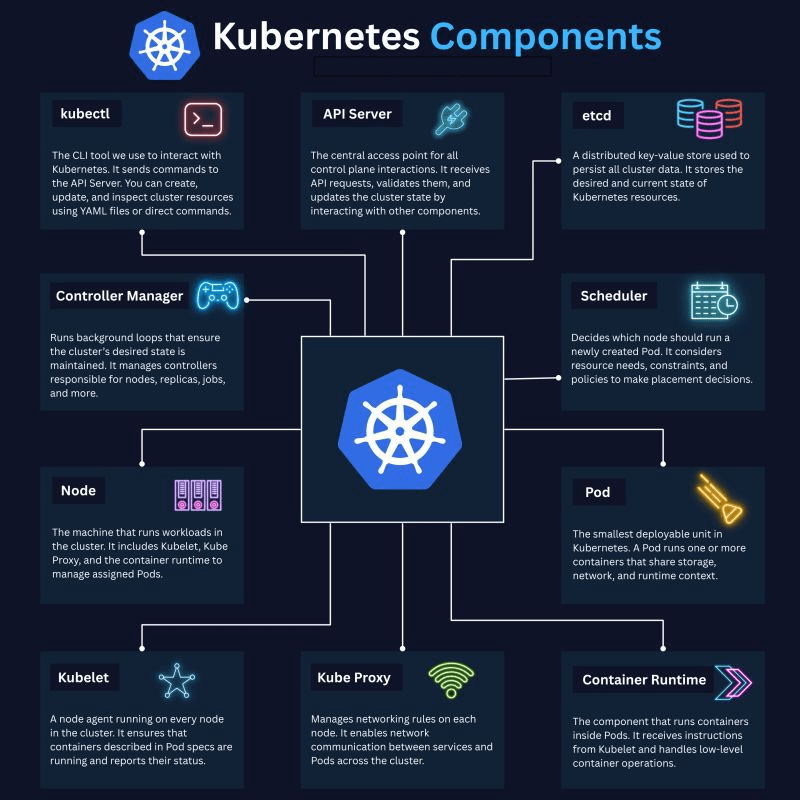Master Kubernetes Components: From kubectl to Container Runtime
Kubernetes has revolutionized how we deploy, manage, and scale containerized applications. At its core, Kubernetes operates through a sophisticated ecosystem of interconnected components, each serving a specific purpose in the orchestration process. Understanding these components is crucial for anyone working with modern container deployments.

The Heart of Kubernetes: Core Components Explained
Control Plane Components
kubectl: Your Command Center The kubectl command-line interface serves as your primary gateway to interact with Kubernetes clusters. This powerful CLI tool enables you to send commands directly to the API server, allowing you to create, update, and inspect cluster resources using YAML files or direct commands. Whether you’re deploying applications or troubleshooting issues, kubectl is your essential companion.
API Server: The Central Nervous System Acting as the central access point for all control plane interactions, the API Server receives requests, validates them, and updates the cluster state by interacting with other components. It’s the heart of Kubernetes communication, ensuring that every operation follows proper authentication and authorization protocols.
etcd: The Memory Bank This distributed key-value store serves as Kubernetes’ persistent memory, storing all cluster data including the desired and current state of all Kubernetes resources. etcd’s reliability and consistency are fundamental to maintaining cluster integrity and enabling recovery from failures.
Controller Manager: The Orchestrator Running background loops that ensure the cluster’s desired state is maintained, the Controller Manager handles controllers responsible for nodes, replicas, jobs, and more. It continuously monitors the cluster and takes corrective actions when the actual state diverges from the desired state.
Scheduler: The Strategic Planner The Scheduler makes intelligent decisions about which node should run newly created Pods. It considers resource needs, constraints, and policies to make optimal placement decisions, ensuring efficient resource utilization across the cluster.
Node Components
Node: The Workhorses Nodes are the physical or virtual machines that run workloads in the cluster. Each node includes Kubelet, Kube Proxy, and the Container Runtime, working together to manage assigned Pods and maintain communication with the control plane.
Kubelet: The Node Agent A node agent running on every node in the cluster, Kubelet ensures that containers described in Pod specs are running and reports their status back to the control plane. It acts as the primary interface between the node and the Kubernetes API.
Kube Proxy: The Network Manager Managing networking rules on each node, Kube Proxy enables network communication between services and Pods across the cluster. It maintains network routing tables and handles load balancing for service endpoints.
Container Runtime: The Execution Engine The component that runs containers inside Pods, the Container Runtime receives instructions from Kubelet and handles low-level container operations including image pulling, container creation, and lifecycle management.
Application Components
Pod: The Atomic Unit The smallest deployable unit in Kubernetes, a Pod runs one or more containers that share storage, network, and runtime context. Pods represent the basic building blocks of your applications in the Kubernetes ecosystem.
How It All Works Together
These components form an intricate dance of communication and coordination. When you deploy an application using kubectl, the request flows through the API Server to etcd for storage, triggers the Controller Manager to create necessary resources, prompts the Scheduler to assign Pods to nodes, and finally activates Kubelet to start containers through the Container Runtime.
The beauty of Kubernetes lies in this distributed architecture where each component has a specific responsibility, yet they all work together seamlessly to provide a robust, scalable, and self-healing container orchestration platform.
Key Takeaways
Understanding Kubernetes components is essential for:
- Effective troubleshooting and debugging
- Optimizing cluster performance and resource utilization
- Implementing proper security and networking policies
- Scaling applications efficiently
- Maintaining cluster health and reliability
Whether you’re a developer deploying applications or a DevOps engineer managing infrastructure, mastering these components will significantly enhance your Kubernetes expertise and operational capabilities.
Ready to dive deeper into Kubernetes? Start by exploring each component in your own cluster and observe how they interact during application deployments and scaling operations.






